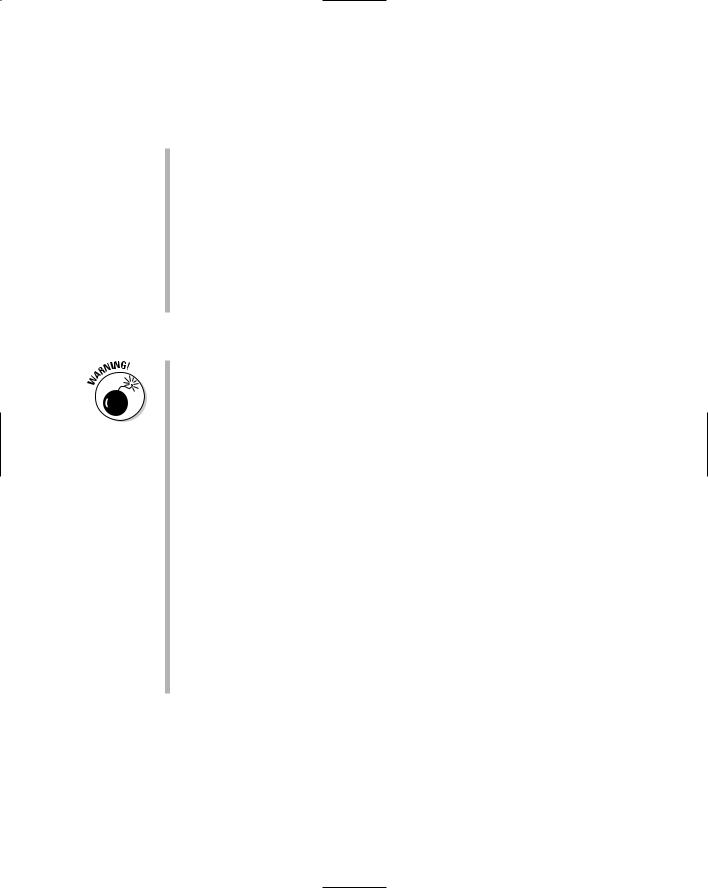
Accounting For Dummies, 4th edition
.pdf
150 Part II: Figuring Out Financial Statements
When product costs are steadily increasing, many (but not all) businesses follow a first-in, first-out sales price strategy and hold off raising sales prices as long as possible. They delay raising sales prices until they have sold their lower-cost products. Only when they start selling from the next batch of products, acquired at a higher cost, do they raise sales prices. I favor using the FIFO cost of goods sold expense method when a business follows this basic sales pricing policy, because both the expense and the sales revenue are better matched for determining gross margin. I realize that sales pricing is complex and may not follow such a simple process, but the main point is that many businesses use a FIFObased sales pricing approach. If your business is one of them, I urge you to use the FIFO expense method to be consistent with your sales pricing.
The LIFO (last-in, first-out) method
Remember the movie ticket-taker I mentioned earlier? Think about that tickettaker going to the back of the line of people waiting to get into the next showing and letting them in first. The later you bought your ticket, the sooner you get into the theater. This is the LIFO method, which stands for last-in, first-out. The people in the front of a movie line wouldn’t stand for it, of course, but the LIFO method is acceptable for determining the cost of goods sold expense for products sold during the period.
The main feature of the LIFO method is that it selects the last item you purchased first, and then works backward until you have the total cost for the total number of units sold during the period. What about the ending inventory — the products you haven’t sold by the end of the year? Using the LIFO method, the earliest cost remains in the inventory asset account (unless all products are sold and the business has nothing in inventory).
Using the same example from the preceding section, assume that the business uses the LIFO method instead of FIFO. The four units, in order of acquisition, had costs of $100, $102, $104, and $106. If you sell three units during the period, the LIFO method calculates the cost of goods sold expense as follows:
$106 + $104 + $102 = $312
The ending inventory cost of the one unit not sold is $100, which is the oldest cost. The $412 total cost of the four units acquired less the $312 cost of goods sold expense leaves $100 in the inventory asset account. Determining which units you actually delivered to customers is irrelevant; when you use the LIFO method, you always count backward from the last unit you acquired.

Chapter 7: Choosing Accounting Methods: Different Strokes for Different Folks 151
The two main arguments in favor of the LIFO method are these:
Assigning the most recent costs of products purchased to the cost of goods sold expense makes sense because you have to replace your products to stay in business, and the most recent costs are closest to the amount you will have to pay to replace your products. Ideally, you should base your sales prices not on original cost but on the cost of replacing the units sold.
During times of rising costs, the most recent purchase cost maximizes the cost of goods sold expense deduction for determining taxable income, and thus minimizes income tax. In fact, LIFO was invented for income tax purposes. True, the cost of inventory on the ending balance sheet is lower than recent acquisition costs, but the taxable income effect is more important than the balance sheet effect.
But here are the reasons why LIFO is problematic:
Unless you are able to base sales prices on the most recent purchase costs or you raise sales prices as soon as replacement costs increase — and most businesses would have trouble doing this — using LIFO depresses your gross margin and, therefore, your bottom-line net income.
The LIFO method can result in an ending inventory cost value that’s seriously out of date, especially if the business sells products that have very long lives. For instance, for several years, Caterpillar’s LIFO-based inventory has been about $2 billion less than what it would have been under the FIFO method.
Unscrupulous managers can use the LIFO method to manipulate their profit figures if business isn’t going well. They deliberately let their inventory drop to abnormally low levels, with the result that old, lower product costs are taken out of inventory to record cost of goods sold expense. This gives a one-time boost to gross margin. These “LIFO liquidation gains” — if sizable in amount compared with the normal gross profit margin that would have been recorded using current costs — have to be disclosed in the footnotes to the company’s financial statements. (Dipping into old layers of LIFO-based inventory cost is necessary when a business phases out obsolete products; the business has no choice but to reach back into the earliest cost layers for these products. The sales prices of products being phased out usually are set low, to move the products out of inventory, so gross margin is not abnormally high for these products.)
If you sell products that have long lives and for which your product costs rise steadily over the years, using the LIFO method has a serious impact on the ending inventory cost value reported on the balance sheet and can cause the balance sheet to look misleading. Over time, the current cost of replacing products becomes further and further removed from the LIFO-based inventory costs. Your 2009 balance sheet may very well include products with 1999, 1989, or 1979 costs. As a matter of fact, the product costs reported for inventory could go back even further.

152 Part II: Figuring Out Financial Statements
Note: A business must disclose in a footnote with its financial statements the difference between its LIFO-based inventory cost value and its inventory cost value according to FIFO. However, not too many people outside of stock analysts and professional investment managers read footnotes very closely.
Business managers get involved in reviewing footnotes in the final steps of getting annual financial reports ready for release (refer to Chapter 12). If your business uses FIFO, ending inventory is stated at recent acquisition costs, and you do not have to determine what the LIFO value would have been.
Many products and raw materials have very short lives; they’re regularly replaced by new models (you know, with those “New and Improved!” labels) because of the latest technology or marketing wisdom. These products aren’t around long enough to develop a wide gap between LIFO and FIFO, so the accounting choice between the two methods doesn’t make as much difference as with long-lived products.
The average cost method
If you were to make an exhaustive survey of businesses, you would find out that some businesses use methods other than FIFO and LIFO to measure cost of goods sold expense and inventory cost. Furthermore, you would discover variations on how LIFO is implemented. I don’t have the space in this book to explain all the methods. Instead, I’ll quickly mention a third basic method: the average cost method.
Compared with the FIFO and LIFO methods, the average cost method seems to offer the best of both worlds. The costs of many things in the business world fluctuate, and business managers tend to focus on the average product cost over a time period. Also, the averaging of product costs over a period of time has a desirable smoothing effect that prevents cost of goods sold from being overly dependent on wild swings of one or two acquisitions.
However, to many businesses, the compromise aspect of the average cost accounting method is its worst feature. Businesses often want to go one way or the other and avoid the middle ground. If they want to minimize taxable income, LIFO gives the best effect during times of rising prices. Why go only halfway with the average cost method? If the business wants its ending inventory to be as near to current replacement costs as possible, FIFO is better than the average cost method. Plus, recalculating averages every time product costs change, even with computers, is a real pain in the posterior. But the average cost method is an acceptable method under GAAP and for income tax purposes.

Chapter 7: Choosing Accounting Methods: Different Strokes for Different Folks 153
Recording Inventory Losses under the Lower of Cost or Market (LCM) Rule
Acquiring and holding an inventory of products involves certain unavoidable economic risks:
Deterioration, damage, and theft risk: Some products are perishable or otherwise deteriorate over time, which may be accelerated under certain conditions that are not under the control of the business (such as the air conditioning going on the blink). Most products are subject to damage when they’re handled, stored, and moved (for example when the forklift operator misses the slots in the pallet and punctures the container). Products may be stolen (by employees and outsiders).
Replacement cost risk: After you purchase or manufacture a product, its replacement cost may drop permanently below the amount you paid (which usually also affects the amount you can charge customers for the products).
Sales demand risk: Demand for a product may drop off permanently, forcing you to sell the products below cost just to get rid of them.
Regardless of which method a business uses to record cost of goods sold and inventory cost, it should apply the lower of cost or market (LCM) test to inventory. A business should regularly inspect its inventory very carefully to determine loss due to theft, damage, and deterioration. And the business should go through the LCM routine at least once a year, usually near or at year-end. The process consists of comparing the cost of every product in inventory — meaning the cost that’s recorded for each product in the inventory asset account according to the FIFO or LIFO method (or whichever method the company uses) — with two benchmark values:
The product’s current replacement cost (how much the business would pay to obtain the same product right now)
The product’s net realizable value (how much the business can sell the product for)
If a product’s cost on the books is higher than either of these two benchmark values, an accounting entry is made to decrease product cost to the lower of the two. In other words, inventory losses are recognized now rather than later, when the products are sold. The drop in the replacement cost or sales value of the product should be recorded now, on the theory that it’s better to take your medicine now than to put it off. Also, the inventory cost value on the balance sheet is more conservative because inventory is reported at a lower cost value.

154 Part II: Figuring Out Financial Statements
Determining current replacement cost values for every product in your inventory isn’t easy! When I worked for a CPA firm many years ago, we tested the ways clients applied the LCM method to their ending inventories. I was surprised by how hard it was to pin down current market values — vendors wouldn’t quote current prices or had gone out of business, prices bounced around from day to day, suppliers offered special promotions that confused matters, and on and on. Applying the LCM test leaves much room for interpretation.
Some shady characters abuse LCM to cheat on their income tax returns. They knock down their ending inventory cost value — decrease ending inventory cost more than can be justified by the LCM test — to increase the deductible expenses on their income tax returns and thus decrease taxable income. A product may have proper cost value of $100, for example, but a shady character may invent some reason to lower it to $75 and thus record a $25 inventory write-down expense in this period for each unit — which is not justified. But, even though the person can deduct more this year, he or she will have a lower inventory cost to deduct in the future. Also, if the person is selected for an IRS audit and the Feds discover an unjustified inventory knockdown, the person may end up with a felony conviction for income tax evasion.
Appreciating Depreciation Methods
In theory, depreciation expense accounting is straightforward enough: You divide the cost of a fixed asset (except land) among the number of years that the business expects to use the asset. In other words, instead of having a huge lump-sum expense in the year that you make the purchase, you charge a fraction of the cost to expense for each year of the asset’s lifetime. Using this method is much easier on your bottom line in the year of purchase, of course.
Theories are rarely as simple in real life as they are on paper, and this one is no exception. Do you divide the cost evenly across the asset’s lifetime, or do you charge more to certain years than others? Furthermore, when it eventually comes time to dispose of fixed assets, the assets may have some disposable, or salvage, value. In theory, only cost minus the salvage value should be depreciated. But in actual practice most companies ignore salvage value and the total cost of a fixed asset is depreciated. Moreover, how do you estimate how long an asset will last in the first place? Do you consult an accountant psychic hot line?
As it turns out, the IRS runs its own little psychic business on the side, with a crystal ball known as the Internal Revenue Code. Okay, so the IRS can’t tell you that your truck is going to conk out in five years, seven months, and two days. The Internal Revenue Code doesn’t give you predictions of how long your fixed assets will last; it only tells you what kind of time line to use for income tax purposes, as well as how to divide the cost along that time line.

Chapter 7: Choosing Accounting Methods: Different Strokes for Different Folks 155
Hundreds of books have been written on depreciation, but the book that really counts is the Internal Revenue Code. Most businesses adopt the useful lives allowed by the income tax law for their financial statement accounting; they don’t go to the trouble of keeping a second depreciation schedule for financial reporting. Why complicate things if you don’t have to? Why keep one depreciation schedule for income tax and a second for preparing your financial statements?
Note: The tax law can change at any time, and you can count on the tax law to be extremely technical. The following discussion is meant only as a basic introduction and certainly not as tax advice. The annual income tax guides, such as Taxes For Dummies by Eric Tyson, Margaret Atkins Munro, and David J. Silverman (Wiley), go into the more technical details of calculating depreciation.
The IRS rules offer two depreciation methods that can be used for particular classes of assets. Buildings must be depreciated just one way, but for other fixed assets you can take your pick:
Straight-line depreciation: With this method, you divide the cost evenly among the years of the asset’s estimated lifetime. Buildings have to be depreciated this way. Assume that a building purchased by a business cost $390,000, and its useful life — according to the tax law — is 39 years. The depreciation expense is $10,000 (1/39 of the cost) for each of the 39 years. You may choose to use the straight-line method for other types of assets. After you start using this method for a particular asset, you can’t change your mind and switch to another depreciation method later.
Accelerated depreciation: Actually, this term is a generic catchall for several different kinds of methods. What they all have in common is that they’re front-loading methods, meaning that you charge a larger amount of depreciation expense in the early years and a smaller amount in the later years. The term accelerated also refers to adopting useful lives that are shorter than realistic estimates. (Very few automobiles are useless after five years, for example, but they can be fully depreciated over five years for income tax purposes.)
One popular accelerated method is the double-declining balance (DDB) depreciation method. With this method, you calculate the straightline depreciation rate, and then you double that percentage. You apply that doubled percentage to the declining balance over the course of the asset’s depreciation time line. After a certain number of years, you switch back to the straight-line method to ensure that you depreciate the full cost by the end of the predetermined number of years.
The salvage value of fixed assets (the estimated disposal values when the assets are taken to the junkyard or sold off at the end of their useful lives) is ignored in the calculation of depreciation for income tax. Put another way, if a fixed asset is held to the end of its entire depreciation life, then its original cost will be fully depreciated, and the fixed asset from that time forward will

156 Part II: Figuring Out Financial Statements
have a zero book value. (Recall that book value is equal to original cost minus the balance in the accumulated depreciation account.)
Fully depreciated fixed assets are grouped with all other fixed assets in external balance sheets. All these long-term resources of a business are reported in one asset account called property, plant, and equipment (usually not “fixed assets”). If all its fixed assets were fully depreciated, the balance sheet of a company would look rather peculiar — the cost of its fixed assets would be offset by its accumulated depreciation. Keep in mind that the cost of land (as opposed to the structures on the land) is not depreciated. The original cost of land stays on the books as long as the business owns the property.
The straight-line depreciation method has strong advantages: It’s easy to understand, and it stabilizes the depreciation expense from year to year. Nevertheless, many business managers and accountants favor an accelerated depreciation method in order to minimize the size of the checks they have to write to the IRS in the early years of using fixed assets. This lets the business keep the cash, for the time being, instead of paying more income tax. Keep in mind, however, that the depreciation expense in the annual income statement is higher in the early years when you use an accelerated depreciation method, and so bottom-line profit is lower. Many accountants and businesses like accelerated depreciation because it paints a more conservative (a lower or more moderate) picture of profit performance in the early years. Who knows? Fixed assets may lose their economic usefulness to a business sooner than expected. If this happens, using the accelerated depreciation method would look very wise in hindsight.
Except for brand-new enterprises, a business typically has a mix of fixed assets — some in their early years of depreciation, some in their middle years, and some in their later years. So, the overall depreciation expense for the year may not be that different than if the business had been using straight-line depreciation for all its depreciable fixed assets. A business does not have to disclose in its external financial report what its depreciation expense would have been if it had been using an alternative method. Readers of the financial statements cannot tell how much difference the choice of accounting methods would have caused in depreciation expense that year.
Scanning the Expense Horizon
Recording sales revenue and other income can present some hairy accounting problems. As a matter of fact, the Financial Accounting Standards Board (FASB) — the private sector authority that sets accounting and financial reporting standards in the United States — ranks revenue recognition as a major problem area. A good part of the reason for putting revenue recognition high on the list of accounting problems is that many high profile financial accounting frauds have involved recording bogus sales revenue that had no

Chapter 7: Choosing Accounting Methods: Different Strokes for Different Folks 157
economic reality. Sales revenue accounting presents challenging problems in some situations. But in my view, the accounting for many key expenses is equally important. Frankly, it’s damn difficult to measure expenses on a year- by-year basis.
I could write a book on expense accounting, which would have at least 20 or 30 major chapters. All I can do here is to call your attention to a few major expense accounting issues.
Asset impairment write-downs: Inventory shrinkage, bad debts, and depreciation by their very nature are asset write-downs. Other asset write-downs are required when an asset becomes impaired, which means that it has lost some or all of its economic utility to the business and has little or no disposable value. An asset write-down reduces the book (recorded) value of an asset (and at the same time records an expense or loss of the same amount). A write-off reduces the asset’s book value to zero and removes it from the accounts, and the entire amount becomes an expense.
Employee-defined benefits pension plans and other post-retirement benefits: The GAAP rule on this expense is extremely complex. Several key estimates must be made by the business, including, for example, the expected rate of return on the investment portfolio set aside for these future obligations. This and other estimates affect the amount of expense recorded. In some cases, a business uses an unrealistically high rate of return in order to minimize the amount of this expense.
Certain discretionary operating expenses: Many operating expenses involve timing problems and/or serious estimation problems. Furthermore, some expenses are very discretionary in nature, which means how much to spend during the year depends almost entirely on the discretion of managers. Managers can defer or accelerate these expenses in order to manipulate the amount of expense recorded in the period. For this reason, businesses filing financial reports with the SEC are required to disclose certain of these expenses, such as repairs and maintenance expense, and advertising expense. (To find examples, go to the EDGAR database of the Securities and Exchange Commission at www.sec.gov.)
Income tax expense: A business can use different accounting methods for some of the expenses reported in its income statement than it uses for calculating its taxable income. Oh, boy! The hypothetical amount of taxable income, as if the accounting methods used in the income statement were used in the tax return, is calculated; then the income tax based on this hypothetical taxable income is figured. This is the income tax expense reported in the income statement. This amount is reconciled with the actual amount of income tax owed based on the accounting methods used for income tax purposes. A reconciliation of the two different income tax amounts is provided in a technical footnote schedule to the financial statements.

158 Part II: Figuring Out Financial Statements
Management stock options: A stock option is a contract between an executive and the business that gives the executive the option to purchase a certain number of the corporation’s capital stock shares at a fixed price (called the exercise or strike price) after certain conditions are satisfied. Usually a stock option does not vest until the executive has been with the business for a certain number of years. The question is whether the granting of stock options should be recorded as an expense. This issue had been simmering for some time. The Financial Accounting Standards Board (FASB) finally issued a pronouncement that requires a value measure be put on stock options when they are issued and that this amount be recorded as an expense.
You could argue that management stock options are simply an arrangement between the stockholders and the privileged few executives of the business, by which the stockholders allow the executives to buy shares at bargain prices. The granting of stock options does not reduce the assets or increase the liabilities of the business, so you could argue that stock options are not a direct expense of the business; instead, the cost falls on the stockholders. Allowing executives to buy stock shares at below-market prices increases the number of shares over which profit has to be spread, thus decreasing earnings per share. Stockholders have to decide whether they are willing to do this; the granting of management stock options must be put to a vote by the stockholders.
In any case, the main problem today concerns how to put a value on stock options at the time they are issued to executives. The FASB pronouncement opened the door to alternative methods for calculating the value of stock options. Guess what? More than one method is being used by public businesses to measure the expense of management stock options. This should not be a surprise to anyone. It will take some time for things to settle down on the preferred way to measure the cost of management stock options.
Please don’t think that the short list above does justice to all the expense accounting problems of businesses. U.S. businesses — large and small, public and private — operate in a highly developed and very sophisticated economy. One result is that expense accounting has become very complicated and confusing.

Part III
Accounting in
Managing a
Business
